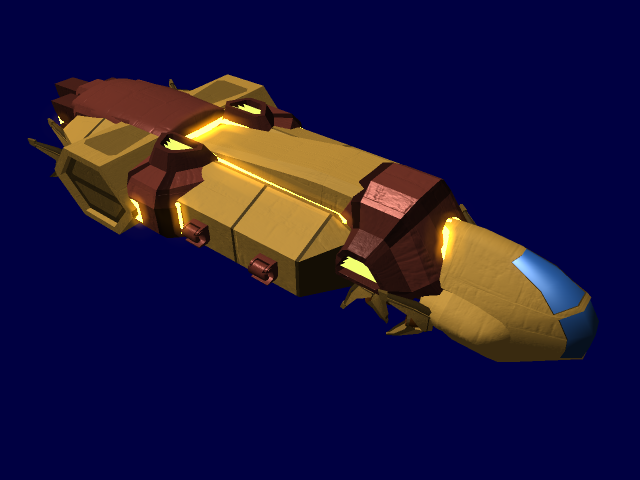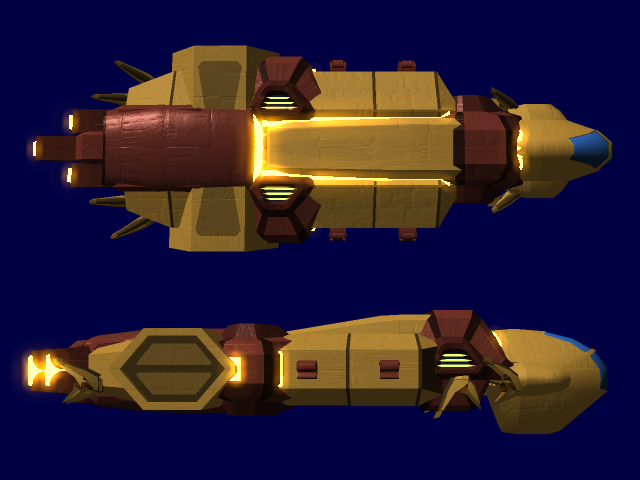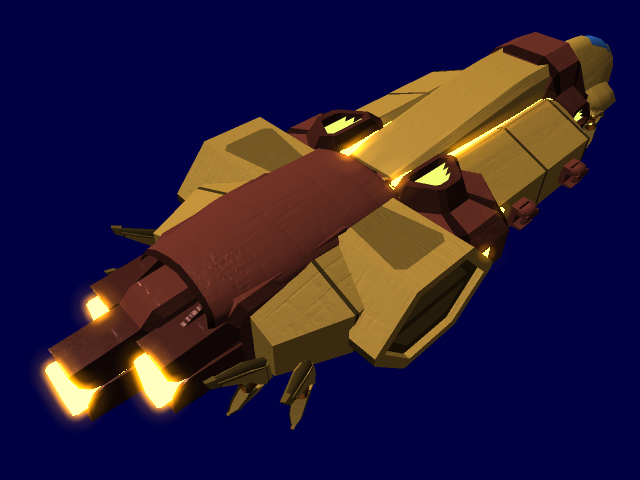Table of Contents
Sigiriya-class Medical Corvette
About the Ship
The Sigiriya-class medical corvette is a small vessel made to search for, and rescue, survivors after a battle. Using its small size, relative agility, and ability to support a small number of powered frames, it excels in the role of rescuing people. On top of this, the Sigiriya has very sophisticated medical equipment for a craft of its size, allowing it to treat injuries and ailments of those it rescues, quickly, and effectively, within the short window of time given by a body after it is damaged.
Key Features
- Frame docking hooks
- Medical center
- Small size
Mission Specialization
The Sigiriya is specialized for search and rescue operations, as well as first response medical aid. It is a purely humanitarian ship, and has absolutely no offensive weaponry.
Appearance
The Sigiriya is a long, flattened shape, with clusters of things breaking up this basic shape. In the rear is the shuttle dock, which juts out past the normal walls of the ship's shape. In the front, the bridge is a vertically-oriented semi-disc, with windows towards the front. Directly behind it is a large hump that acts as a sort of mediator between the disc shape and the flattened shape, helping it to visually flow more smoothly together. The Sigiriya is also covered in MASC fins, giving it a slightly spiky appearance.
History and Background
The Sigiriya was a comission to Ahmida Civilworks at the start of the Third Outer System Conflict, made for the Commonwealth as a non-fighting vessel. Because of the starting of the way, they didn't want to burden Solan starworks, and thus the design was given to the next best thing. Ahmida, eager to show that they could create a design that was just as good as Solan's, as well as to find a way to indirectly help the war, quickly came up with the Sigiriya, which began to prove itself as a quality design as soon as it entered service. Throughout the years the Sigiriya has seen a few upgrades, including the ability to dock with Mechanized frames.
Statistics and Performance
General
Class: See: AC-E7-12B Type: Medical Corvette Designers: Ahmida Civiltech Manufacturer: Ahmida Civiltech Production: Mass-Production Fielded by: Astral Vanguard
Passengers
Crew: 4 operators are recommended, 2 are required. Maximum Capacity: There are accommodations for 8 people. In extreme situations, the Ship can support 16 for a shortened period of time. About 50 people can fit aboard in an emergency, but the ship would be extremely cramped.
Dimensions
Length: 42 meters Width: 15 meters Height: 8.75 meters Decks: 1
Propulsion and Range
MASC Jump: 2200c Sublight Engines: .25c Range: Four Standard months Lifespan: 15 years Refit Cycle: Quarterly
Damage Capacity
See Damage Rating (Version 3) for an explanation of the damage system.
- Hull: 8
- Shields: 6 (Threshold 1)
Inside the Ship
Compartment Layouts
Bridge
The bridge, at about four meters cubed, is anything but spacious, and can seem cramped, especially when a full crew is present. Unlike many other Iromakuanhe starships, it simply consists of a small room with windows to the front, with four chairs. The chairs contain link points which allow an Iromakuanhe to directly link to the ship via their entry ports, and control their assigned function. There is a set of rudimentary backup controls for each station, but as it is little used it has become mostly vestigial and can be a bother to operate.
Engineering
The Sigiriya lacks a dedicated engineering section, having rather a closet full of tools for the mechanically minded to peruse and use as needed.
Medical Center
The Medical center, while abnormally large for a craft of this size, is still fairly small compared to a hospital or a larger ship class. This Medical center consists of a 10m x 10m room, with three Prajna tanks each on two walls, two medical beds, and cabinets along the other two walls containing various and sundry medical supplies. The walls with cabinets also have doors, one heading toward the shuttle dock, and one towards the rest of the ship.
Crew Cabins
There are four small crew cabins, each of which is dual-occupancy. These cabins contain two beds, allowing the ship's full crew to use them, or, in some extreme cases, allowing the ship a full, rotating crew of sixteen. Two rooms are reserved for the Frame Runners, and two for the bridge crew. These rooms do not extend to the full width of the ship, allowing room for various systems, as well as the Frame docking mechanisms.
Passageways
The Ship's passageways are small and cramped, as with the rest of the ship. The main passageways are located on the outer extents of the ship's internal structure, moving from the bridge, back around the rooms, and therefore past the Frame docking mechanisms, and back to the medical center.
Shuttle Dock
The shuttle dock is the largest open space in the Sigiriya, running all the way width-wise on the ship. It has openings on either side, allowing it to dock with up to two shuttles at once. The Shuttle dock is used primarily as a staging area for things such as supplies, passengers, and patients, but is also the main entrance when the Sigiriya is docked or landed.
Ship Systems
Armored Hull and Hull Integrated Systems
Computers and Electronics
Emergency Systems
- The Sigiriya-class uses all of the following Emergency systems, with the exception of the Aerudirn Autosealing and Breach Shields.
Life Support Systems
Propulsion
Power
Shield Systems
Vehicle Complement
Shuttles
While carrying no shuttles of its own, the Sigiriya is capable of docking with various sizes of shuttles, allowing them to pick up and or drop off people and supplies. This allows the Sigiriya to continue its work for extended periods of time, by letting shuttles take stable patients to real hospitals, as well as allowing them to bring fresh supplies, without forcing the Sigiriya to return to a base.
Frames
The Sigiriya can support up to four frames, through the use of its docking hooks, which allow the pilot to board and disembark their frames, as well as helping to refuel. There are two docking hooks on either side of the ship. These hooks work by latching onto the chest of the frame, and creating an airtight seal, allowing the pilot to enter and exit through a small tunnel.


